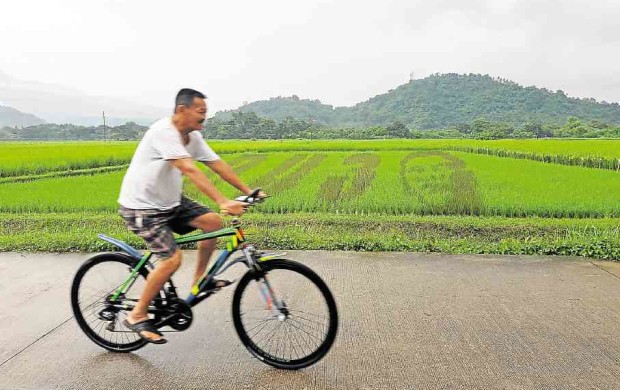‘Du30’ rice paddy in Laguna draws visitors

A RICE paddy in Los Baños town in Laguna province, featuring President Duterte’s image, gives farming a twist. CLIFFORD NUÑEZ / Inquirer Southern Luzon
LOS BAÑOS, Laguna—Now, who says planting rice is easy?
Definitely not, especially when you have to meticulously tweak every inch and corner to turn a rice paddy into a giant art canvas.
On a quiet road past the University of the Philippine Los Baños (UPLB) campus here, rice fields have become a little more exciting to view through paddy art.
The Philippine Rice Research Institute (PhilRice), an agency under the Department of Agriculture, uses the traditional Japanese art form of planting various rice types and colors to create a large image.
And what better way to feature this type of art than dedicate it to President Duterte, the country’s man of the hour?
“It’s about using rice fields as canvas, highlighting arts and culture and science,” said Mario Movillon, PhilRice chief science research specialist.
Movillon said 27 members of PhilRice’s Los Baños team planted rice on a 2,000-square meter plot here on Sept. 3 to create the image.
A little less than a month since, the image—featuring alphanumeric characters “D,” “U,” and “3” and the President’s silhouette resembling a “0”—is visible from the road.
The design was made by Jayson Baldoz, PhilRice’s science research specialist, and engineering students from UPLB.
When the Inquirer visited the site recently, a group of researchers parked their car in front of the paddy and took “selfies” with Mr. Duterte’s image as their background.
They said they heard about it on social media and wanted to see the paddy for themselves.
“Did they color the rice black?” one of them asked.
They said most of them supported Mr. Duterte during the elections and teased one in the group while taking his picture, since he supported then Vice President Jejomar Binay.
Purple, green
No artificial colors were used in creating the paddy art.
Instead, PhilRice combined inbred rice varieties of green and purple to create contrasting colors, said Imelda Olvida of PhilRice’s research and development division.
They also used regular fertilizers to protect the crops from snails, pests and diseases.
Movillon said the agency spent about P6,000 per hectare in preparing the rice paddy.
“With the many challenges that Philippine agriculture faces —climate change, rice shortage, agricultural land conversion, aging and dwindling number of farmers, and the dropping number of agriculture courses enrolees—the Du30 paddy art was conceptualized to make agriculture more popular,” Olvida said.
Agro-ecotourism
Du30 is PhilRice’s third rice paddy art. The other two were the images of popular television love team Alden Richards and Maine “Yaya Dub” Mendoza, and the images of Mr. Duterte and Vice President Leni Robredo. These were planted in PhilRice’s farms in the Science City of Muñoz in Nueva Ecija province.
Movillon said the Du30 paddy will be best viewed on Sept. 30, in time for PhilRice’s Farmers’ Field Day, where the agency invites farmers to tour its experiment stations. The Duterte-Robredo paddy will be best seen by Nov. 7, in time for PhilRice’s anniversary.
“Indirectly, this is also to show our support for the government’s effort to achieve rice sufficiency, which is also our advocacy,” Movillon said.
He said the rice paddy art, also called the “Tanbo Art,” has been popular in Japan, depicting images on farmlands as big as 20 to 100 hectares.
In the Philippines, he said, the art is relatively new and quite “ambitious,” especially since Filipino farmers have smaller land holdings (an average of 2 ha per farmer).
But still, he said, it remains viable for Philippine agro-ecotourism, especially for farmers who wanted to explore their creative side.
The rice paddy art also promotes rice management, “wherein every space or quadrant is preconceived,” Movillon said.














